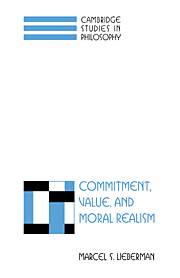4 - Commitment and belief
Published online by Cambridge University Press: 02 December 2009
Summary
BELIEF CONSTRAINTS
Introduction
The aim of the present chapter is to bring the structure of commitment into finer focus by examining what belief constraints apply to commitment and what the content of these beliefs might be. In chapter 2 we saw that this was one of the main steps toward an argument for moral realism. The question of what agents can believe while still remaining committed was a central point of contention in the discussion on Rorty and Gibbard. Recall that I claimed that their neopragmatist and antirealist metaethics were incompatible with the requirements for the possibility of commitment itself. The goal now is to show that (1) beliefs do in fact figure in at least the substantive commitment, and that (2) these are (what I called) realist beliefs. Naturally, I shall begin with (1). Chapter 5 will address (2).
The cognitive component of commitment
Before moving directly to the examination of beliefs and commitment, there is the preliminary question of why we should even think that there is a cognitive component to commitment at all: that is, why should we think of commitment as anything more than a strong desire or a form of self-expression?
One immediate difference between commitments and desires is that the former, while not the latter, are sensitive to the demands of consistency and coherence. I might have a desire to lose weight and eat chocolate, to finish a paper and go see a movie.
- Type
- Chapter
- Information
- Commitment, Value, and Moral Realism , pp. 88 - 133Publisher: Cambridge University PressPrint publication year: 1998



